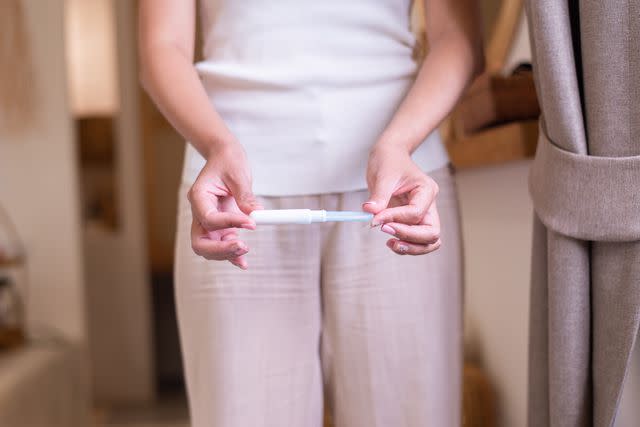Should You Sleep With a Tampon In?
Medically reviewed by Renita White, MD
Sleeping with a tampon can be safe, but it depends on how many hours of sleep you plan to get. If less than eight, the risk of developing a possible infection or other adverse effect lowers, as you should change your tampon at least once every eight hours or less.
Toxic shock syndrome (TSS) and other bacterial infections can develop when you fall asleep with a tampon in for longer than eight hours.
This article discusses the possible risks of wearing a tampon to bed and what you can do to protect yourself.

Piyapong Thongcharoen / Getty Images
Sleeping With Tampons: Possible Risks
The most notable risk associated with wearing a tampon for longer than you should be is toxic shock syndrome. This rare but serious bacterial infection can cause life-threatening symptoms to develop. Leaving a tampon in for too long or overnight can also lead to other bacterial infections, such as bacterial vaginosis and vulvitis.
Infections can occur because the warm and moist environment of the vagina allows bacteria to thrive and overgrow, leading to infections.
Symptoms of Toxic Shock Syndrome
TSS symptoms include:
Fever over 102 degrees F (although it can also develop without a fever)
Chills
Feeling generally unwell or flu-like symptoms
Headache
Fatigue or lethargy
Red and flat rash all over the body
Skin shedding in sheets, often on the soles and palms
Dangerously low blood pressure
Vomiting and nausea
Diarrhea
Muscle pain
Increased blood flow to the vagina, eyes, or mouth
Decreased function of the liver, kidneys, and urine output
Bruising caused by low blood platelets and other bleeding problems
Difficulty breathing
Disorientation
Confusion
Tenderness in the abdomen
Quickened heart rate
High red and white blood cell counts
Less Than Six Hours of Sleep
If you plan on sleeping for under six hours, wearing a tampon is unlikely to cause any issues. This is especially true if you’re wearing one with the lowest absorbency rate for your flow.
Eight Hours of Sleep
Eight hours is the cutoff when wearing a tampon, whether it be while you’re awake or asleep. Any longer than that, and the risk of developing a bacterial infection increases significantly.
More Than 10 Hours of Sleep
Tampons should not be used when sleeping for more than 10 hours. Wearing a sanitary pad during longer periods of sleep can eliminate the risk of bacterial infections.
What If I Accidentally Sleep Longer Than Eight Hours?
If you sleep with a tampon in and go over eight hours, it’s essential to change the tampon as soon as you get up. Since your risk of developing certain infections, including TSS, is higher when wearing a tampon for over eight hours, be aware of symptoms that develop. Seek emergency medical attention if you notice any of the TSS symptoms mentioned above.
A healthcare provider should also address vaginal irritation after sleeping with a tampon for longer than eight hours.
Related: What Light, Regular, Super, and Other Tampon Absorbencies Mean
Tampon Absorbency: How Long Do They Last?
Tampon absorbency varies depending on how heavy or light a person’s flow is at that time. These are the typical sizes and their allotted absorbency rate in grams (g):
Size | Absorbency Rate | When and How to Use the Size Best |
Light | 6 g | Best for use on the lightest days of your period |
Regular | 6–9 g | Can be used throughout your period; the most common size |
Super | 9–12 g | Typically used during the heaviest days of your period or in those with heavier periods |
Super Plus | 12–15 g | Can be used by people who have consistently heavy periods |
Ultra | 15–18 g | Typically reserved for people who have exceptionally heavy periods; the least common size |
The rate at which each tampon lasts will depend on your flow. Heavier flows may require more tampon changes than lighter flows, depending on the absorbency rate of the tampon you use.
Choosing the Right Tampon
When choosing a tampon to match your flow, you'll want to pick one that can absorb it properly. However, you don’t want to choose one too absorbent for your flow. For example, you can wear regular tampons with a heavier flow and change them more often, but you should not use a super-absorbency tampon and leave it in for longer than eight hours so you don’t have to change it as much.
Learn More: Normal Menstruation
Sleeping With Pads: Different Than Tampons?
Many people forgo wearing pads during their periods because they are often more uncomfortable than tampons. However, when sleeping for eight hours or longer, you should opt for a tampon alternative, and pads are a great option.
If you would prefer to use something more natural or reusable, there are options available for that, too, including:
Period underwear
Cloth pads
Menstrual cups
Menstrual Cups and Bacterial Infections
Menstrual cups increase your wear time to up to 12 hours. That said, they also come with a risk of developing TSS if left in too long.
Read Next: 5 Tampon Alternatives to Get You Through the Tampon Shortage
Overnight Tampon Alternatives for Heavy Flow
Choosing the right tampon alternative for a heavy flow is done by assessing the flow rate and then choosing accordingly. Pads often have overnight options that can be used for light, regular, or super flow rates. These variations make sanitary pads the most viable option for overnight protection during your period.
Summary
Wearing a tampon to bed usually is safe if not worn for longer than eight hours. Extended tampon use can lead to the risk of bacterial infections, including toxic shock syndrome.
Read the original article on Verywell Health.

